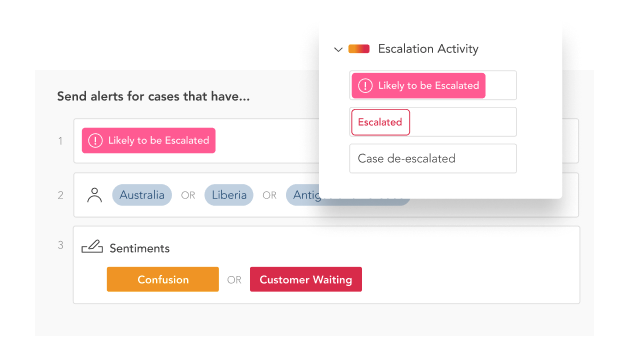
Jul 27, 2021
What Companies Get Wrong About Voice of the Customer (and How to Get It Right)
customer experiencecustomer sentiment analysiscustomer service
From support tickets and sales calls to social media posts, customers tell companies how they feel all the time. So, why do companies ignore those signals and rely on oversimplified metrics and surveys to determine how their customers feel about them? And which Voice of the Customer tools should they use instead?

Customers tell companies how they feel all the time. From support tickets and sales calls to social media posts, there’s no lack of feedback for teams to mine for their Voice of the Customer (VoC) tools and programs.
Brands leverage this invaluable feedback to improve their products, services, and experience—and your bottom line as a result. According to a recent Qualtrics survey, 89% of companies that had “significantly above average” customer experiences tended to outperform their competitors.
So, why do companies ignore those signals and rely on oversimplified metrics and surveys instead of advanced Voice of the Customer tools to determine how their customers feel about them? And what should they do instead?
What is Voice of the Customer?
Voice of the Customer (VoC) is the process of capturing and analyzing how customers feel about a product, service, or brand. Companies use VoC programs to build better products, make campaign and business decisions, improve the customer experience, and measure the performance of customer service teams.
They rely on the wrong Voice of the Customer tools and metrics
Companies use Net Promoter Score (NPS) and customer satisfaction (CSAT) for VoC programs because they’re easy to understand and easy to track. But these metrics oversimplify customer loyalty. They don’t properly capture how a customer feels about a brand or product.
How do you calculate NPS and CSAT?
To get NPS and CSAT, companies typically ask a group of customers a single question like “Would you recommend us to a friend or colleague?” or “How would you describe your experience?” They then lump those customers together based on their positive or negative responses and pit them against the total number of respondents to arrive at an NPS or CSAT score. (We talk about this more in depth in Your Customer Satisfaction Metrics Aren’t Showing You the Whole Picture.)
In terms of Voice of the Customer tools, NPS and CSAT provide a very limited view of how your customers feel. For one, they rely on a customer’s answer to a single question, giving you a mere glimpse of how that customer feels about your product or brand. They also only capture what your customers feel at one moment in time. To get trending NPS and CSAT scores, you would need to follow up with your customers weeks, months, and perhaps even years later.
What’s more, these metrics are subject to sample bias. Companies rarely have the opportunity or resources to get feedback from all of their customers at once. This means they have to choose which customers to prompt for feedback and when. For example, do you reach out to a customer the first week after they start using your product? What about after they complete a support call? The same customer may think very differently about your company in those situations, impacting your NPS and CSAT scores.
Lastly, NPS and CSAT are rearward-looking metrics. Companies prompt customers to answer questions after a transaction or a support call, making it difficult to act on them proactively.
They use the wrong Voice of the Customer tool
Companies turn to customer survey tools to capture NPS and CSAT for their Voice of the Customer tools and programs. While surveys have their benefits, they’re not enough to effectively grasp customer sentiment.
“Every company is looking for ways to operationalize and become more efficient in how they track customer loyalty.”
Surveys are appealing because, like the metrics they capture, they’re easy to use, track, and trend. “Every company is looking for ways to operationalize and become more efficient in how they track customer loyalty,” said Omid Razavi, chief customer officer at SupportLogic.
And they work well for getting customer feedback at the point of a transaction. United Airlines, for example, captures customer sentiment by sending a survey out to each passenger shortly after they disembark from their flight. This tactic works well for getting feedback from a single stakeholder at a single moment. It doesn’t work, however, for a B2B customer with multiple stakeholders. Nor is it effective for tracking customer sentiment over time.
Surveys also do a good job of capturing qualitative feedback when they prompt customers with open-ended responses. However, it’s easier to pay attention to a score than wade through a bunch of free-form feedback. So, companies tend to ignore those rich, qualitative insights. And sometimes they get conflicting information, as in the cases where customers rank a product highly but give very critical feedback in their open-ended reviews.
Get Voice of the Customer right with SupportLogic’s Sentiment Score
So, how do teams reconcile their need for quick, quantitative information while making sure they get the deeper, more accurate insights they need to keep customers happy? SupportLogic’s SX platform does just that. With Sentiment Score, companies get a more accurate, proactive, and complete understanding of how their customers feel—a powerful, new metric to add to their Voice of the Customer tools arsenal.
Better understand how your customer feels
Unlike NPS and CSAT, Sentiment Score utilizes nuanced, empathy-based intelligence. Instead of relying on your customer to accurately rate how they feel with a single question, SupportLogic calculates Sentiment Score using the words your customer uses every time they interact with you.
SupportLogic analyzes word choice and phrasing in service tickets and transcribed calls to detect emotions and detailed feedback. For example, the platform uses natural language processing (NLP) and machine learning (ML) to understand that phrases like “I need to speak to your manager today” signal that the customer is feeling frustrated and urgent.
Over time, we’ve trained the SupportLogic ML model to pick up on phrases that matter most for customer support, sales, and marketing teams. The model is smart enough to distinguish a customer’s feelings about the experience they’re having as opposed to the product or the support rep they’re speaking with.
Every interaction, no matter whether with sales, support, or marketing, gets a Sentiment Score. SupportLogic then aggregates those scores at an account level so your teams can monitor how your customer feels over time.
Say one of your customers has five tickets open with Sentiment Scores of 65, 70, 80, and 52. SupportLogic aggregates those numbers into one overarching score so your teams can easily grasp how your customer is feeling. You can also dig into the details of the lowest score to investigate what happened to make it so low.
Proactively reduce escalations and churn
While many support organizations prioritize tickets based on basic CRM and ticketing information like operating system, topic, or severity rating, SupportLogic users act on their most critical cases with intelligent predictive alerts.
Intelligent predictive alerts notify your team the moment the SupportLogic ML model infers a high-risk sentiment, like confusion or urgency, from a customer. This allows companies to more accurately identify who’s most at risk in real time and act before the situation escalates.
In fact, data analytics companies Qlik and Databricks reduced their customer escalations by 30% and 40%, respectively, using SupportLogic’s intelligent predictive alerts. Another data analytics leader, Fivetran, decreased their customer churn by 25%.

You get full control over what situations or sentiments trigger an alert. Use SupportLogic’s intelligent “likely to be escalated” alert as is, or customize it by choosing which sentiments to watch for and adding parameters like customer location or SLA status. Then decide who gets alerted (support team or a specific engineer?) and how (Slack, Microsoft Teams, or email?).
Pick metrics and tools that grow smarter with you
Machine learning models learn and adapt over time. When your company partners with SupportLogic, they get access to our proprietary ML model, something we’ve trained specifically to help customer-facing teams. Like cultivating bacteria in a Petri dish, we’ve fed the model with specific data.
That doesn’t stop when you partner with us. We continue to feed and finetune your model to best suit your team and customers’ needs so you see value within three months.
Get started with a test drive today.
Don’t miss out
Want the latest B2B Support, AI and ML blogs delivered straight to your inbox?





